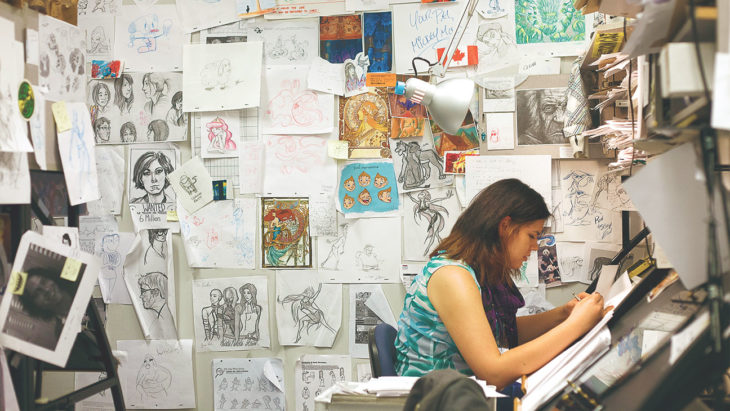Contents
A new kind of art
Visual effects for film have always been an art form, ever since the days of composite photography, post-production coloration, and miniature work.
Effects companies like Industrial Light & Magic, founded by George Lucas in 1975, pushed effects forward through innovative techniques and impressive craftsmanship.
The early 90s played host to a whole new landscape of effects, which arrived in the form of computer-generated graphics, now commonly referred to as CG.
Over the last few years, big-name filmmakers have been combining post-production and CG effects work with practical on-set effects to create movies that are more immersive and believable than ever. Every day, new ways of immersing real sets with CGI emerge.
If you’re hoping to become an effects artist yourself, this decades-long legacy can seem daunting.
Where do you even start? How can someone get started with CG and digital effects work if they don’t already know industry professionals?
If these questions have been keeping you up at night, then you’re in for a real treat. The Frisky had the chance to interview VFX pro Fernando “Fefo” De Souza about his early days in the industry and how VFX hopefuls can get their feet wet with composition, CG, and effects work.
In the unlikely event you don’t already know about his past work, he’s worked on movies like The Avengers, X-Men: Days of Future Past, and Life of Pi, as well as major TV shows and commercial campaigns.
De Souza will be giving occasional tips for aspiring VFX artists. But that’s enough preamble. Let’s talk about how you can explore visual effects and maybe even become an industry professional yourself.
Getting started

Source: hollywoodreporter
For many people who work in visual effects, it all started with an interest in the arts.
If you don’t have the opportunity to work on a video project, focus instead on training your eye to appreciate different types of art and watch as many movies and shows as you can. Absorbing the work of professionals can be a great first step and will have a positive impact on your work later on down the road.
Beginner programs

Source: noroff
So let’s say you’re ready to try your hand at actual visual effects and CG. Sure, you could purchase professional-grade software, but these programs can cost anywhere from a few hundred dollars to more than a thousand dollars for permanent access to industry-standard software.
If you’re looking for a softer introduction, there are plenty of more accessible programs out there, especially for students.
Adobe offers subscription discounts for students, though you won’t be able to access programs for free.
Blender is a great example of a completely free software program that lets you explore 3D modeling and animation. This program is open-source, meaning various programmers have been updating it pro bono for years now, and you can too if you’re so inclined.
No, you won’t be creating Hollywood-ready CG projects with these programs, but they offer the perfect chance to see whether you enjoy this kind of work and put your ideas to the test.
A foot in the door

Source: columbiacollege
Once you’ve gotten a good handle on effects work and CG, the next big step is to get your foot in the door by finding semi-professional and professional projects to work on.
Obviously, networking can be a huge help in this department, so try to make as many contacts as you can.
For De Souza, there was one project in particular that gave him the chance to work with talented Hollywood pros while also being able to showcase his talents.
“One of the many great moments in my career was the Montana Meth Project. Alejandro Iñárritu had been Oscar-nominated for Babel shortly before this project, and I was very flattered to work with him. VFX supervising and leading compositing for that project had a big impact on my career.”
If you stick with it, you will get your chance to show what you’re capable of, and that’s why it’s so important to practice as much as possible before you get to this point.
By the time you’re working with Hollywood and television professionals, the other members of the production want to trust that you know exactly what you’re doing.
Don’t let them down. Train up as much as you can, and if you find yourself in a situation where you don’t know what to do or you won’t be able to meet a deadline, be honest and ask for help.
It’s not an ideal situation, but communicating clearly will help you earn respect from your peers.
The renaissance approach

Source: ausfilm
Once you’ve earned yourself a spot on several mid-size to major productions, you may be tempted to coast on your past successes.
But instead of resting on your laurels, focus on finding new skills and new interests. This will keep your mind sharp and you’ll stay challenged creatively.
We could call this the Renaissance Man approach. Don’t settle for being good at just one thing; learn about many different subjects and use all of it to influence your creativity.
Challenge yourself. Try your hand at hobbies you’ve only ever viewed from a distance. Creativity isn’t predictable, and the more you consume and understand, the more you’ll be able to draw from when you need some fresh inspiration.
Looking back

Source: youtube
At the tail end of our interview with De Souza, we asked whether he had any regrets when he looks back at his career.
He had this to say:
“I am very happy at this point in my life. If I were to start over, the only thing I would do differently is make more of an effort to study art. I deeply enjoy learning about contemporary and classical art, and I would definitely focus more on that if I was young again. But all things considered, I’m very glad to have built such a wonderful career.”
There’s an important lesson here, especially for artists of all kinds: don’t let yourself stagnate. If there’s something you want to explore, go ahead and do it.
Your life can inform your artistic career and vice versa. Especially here in the internet age, there’s no excuse to not expand your knowledge of the world and how you can have a positive impact with your work.
Even after you find success, there’s always another hill to be climbed. In many ways, that’s what makes anything in life compelling.
